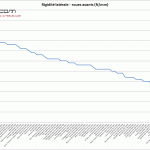
Stiffness tests
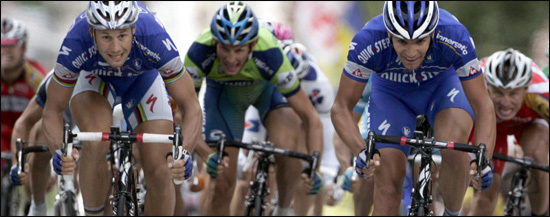 Photo by Alessandro Trovati
Photo by Alessandro Trovati
We are delighted to finally publish the third part of The RouesArtisanales 2008 great wheel test focusing on stiffness – a somewhat hazy and complicated concept. Continuer la lecture

 Photo by Alessandro Trovati
Photo by Alessandro Trovati
We are delighted to finally publish the third part of The RouesArtisanales 2008 great wheel test focusing on stiffness – a somewhat hazy and complicated concept. Continuer la lecture

Zero Gravity

Negative G calipers, from Zero Gravity, were unveiled a few month ago. They now come in a limited edition, in red colour, which
Shimano offers since a couple of weeks its latest 7850 C24 CL clincher carbon/alloy wheels, to test ride through the whole Europe, via the dealers.
It seems like the results are very good since the marks rarely are under 3,5/5. More informations on the official site: |
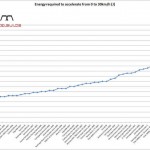
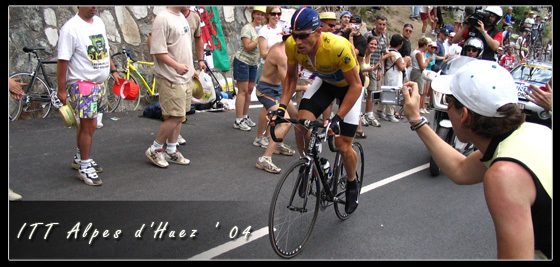 Photo credit : www.photos-dauphine.com
Photo credit : www.photos-dauphine.com
Our second installment focuses on inertia – another very important characteristic. Inertia has a signficicant impact on performance, although it has to be viewed in the context
of the total weight of bike and rider. Continuer la lecture
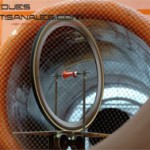

The windtunnel gives some useful insights into the test wheels’ aerodynamic performance. Drag measured in the wind tunnel is a reasonable indicator of the wake generated behind the wheel. Continuer la lecture

After the good response to our 2005 and 2006 wheel tests, we would like to update the series, finally helping you to make the right choice, without being blinded by marketing or simple
stiffness results that don’t truly reflect how wheels perform on the road.
We mustn’t forget that a wheel is made up of several interdependent parts that work together. Performance on the road depends in part on each of these parameters, taken separately!
Aerodynamics, inertia and bearing friction are at least as important as lateral stiffness. However, these factors are rarely evaluated in the available magazine tests.
The results, proposed in the following pages, have been performed by the German magazine Tour, then, more recently, by the French
magazine L’Acheteur Cycliste. Where tests have been performed using the same protocol, we can compare the results
directly.
Between 60 and 77 wheelsets have been tested and we hope you will like this data base as much as we do.
Part 1 – Aerodynamics
Part 2 – Inertia
Part 3 – Stiffness
Part 4 – Bearing resistance
Part 5 – Conclusion

Link great wheel test 2008 version
The last year in August we were glad to analyse the wheels test performed by the german magasine called TOUR. This year, they have done it again with some
other models. The protocol is similar to assure the tests reproductibility. An important data base is available and we propose it here.
Aérodynamism: Ability of a wheel to penetrate the airflow. The lowest this number is, the better is the wheel. The unit is the Watt. In the test,
the watts absorbed at 30, 40 et 50km/h are given. We will only use the figure at 50km/h.
Inertia: Ability of the wheel to keep its speed. The lowest the value, the easier is the wheel to change its speed (acceleration or deceleration).
On the other hand, the higher the value, the longer the wheel keeps its speed. The inertia directly translates the behaviour of the wheels, it’s a more important value than the weight itself. The
unit is the Joule in this test but normaly the gr/mm², see the measure protocol to know more.
Lateral stiffness: Ability of the wheel to lateraly move under strain. The highest the value, the less flexy is the wheel under your pedal stroke
and while cornering. So it translates the stiffness of the wheel and how much it will flex when the wheel won’t be perpendicular to the ground. The unit is the N/mm.
Weight limit: Maximal user weight for a safe use. Over this limit, one should contact the manufacturer to know if the wheels can be used because it
may be dangerous.
Protocols:
Aerodynamism test: The test was performed at the Technical University of Lyon. The open windtunnel design has been optimized for wheel testing by
Mavic. Only front wheels are tested. Wind speed is 50km/h. The wind and drive forces of the belt driven wheel is measured. Using this method both aero drag and drag that’s caused by the rotating
wheel itself can be measured. The aero drag is tested at several angles by turning the wheel away from the wind direction between 0 to 15 degrees. The testing procedure is fully automated. In every
position 3 test values are taken which have to correlate closely to each other for the test to be valid. The curve only represents data taken from a single speed.
Inertia test: The wheel is hung up with a magnet at the bottom. They then swing it and the tachometer at the bottom measures the period duration.
They repeat the test 3 times. Then, calculate the energy required to accelerate the front and rear wheelset including tires to 30km/h. (see this page)
Lateral stiffness test: Wheel is fixated with a skewer to their testing equipment. A line is tied to the rim between the spokes. The force necessary
to deflect/pull the wheel sideways and the resulting amount of movement are registered by computer. The resulting value is N/mm and it take from both front and rear wheel.
2005 and 2006 results by alphabetical order:
| Model | Aero (W) | Inertia (J) |
Lateral stiffness front / rear
(N/mm²) |
Weight limit (Kg) |
| Ambrosio X-Carbo | 31,5 | 114 | 65 / 40 | 90 |
| Bontrager Race X Lite Carbon aero | 23,4 | 105 | 67 / 44 | no limit |
| Campagnolo Eurus | 27,8 | 123 | 61 / 58 | 82 |
| Campagnolo Hyperon | 32,1 | 97 | 55 / 53 | 82 |
| Campagnolo Bora G3 | 23 | 103 | 53 / 44 | 82 |
| Citec 3000S | 30,6 | 127 | 57 / 56 | 99 |
| Citec 3000S Aero | 25,5 | 129 | 55 / 56 | 89 |
| CKT Splendor | 21,7 | 115 | 64 / 54 | 110 |
| Corima Aero | 24,7 | 106 | 65 / 38 | no limit |
| Corima Turbospoke | 23,1 | 111 | 34 / 34 | no limit |
| Easton Tempest II Carbon | 21,6 | 101 | 61 / 46 | no limit |
| FRM FL-R 23 SD Aerolight | 24,6 | 105 | 53 / 32 | no limit |
| FSA RD-600 | 28,7 | 124 | 40 / 33 | no limit |
| Fulcrum Racing Speed | 23,7 | 102 | 55 / 42 | no limit |
| Gipiemme Carbon 5-5 | 24,1 | 148 | 68 / 40 | 120 |
| HED Hed 3 | 19,7 | 129 | 36 / 35 | 100 |
| Lightweight Obermayer | 24,8 | 84 | 78 / 57 | 80 |
| Lightweight Ventoux/Standard | 27,3 | 88 | 55 / 50 | no limit |
| Mavic Aksium Race | 30,0 | 143 | 74 / 48 | no limit |
| Mavic Ksyrium ES | 33,2 | 120 | 56 / 47 | no limit |
| Mavic Cosmic Carbone SL | 21,9 | 143 | 59 / 53 | 100 |
| Ritchey WCS Carbon | 19,3 | 97 | 37 / 32 | no limit |
| Rose Aerospoke | 23,0 | 165 | 33 / 29 | no limit |
| Shimano WH-7801 Carbon 50 | 22,9 | 110 | 78 / 51 | no limit |
| Shimano WH-7801 Carbon | 24,4 | 98 | 64 / 51 | no limit |
| Shimano WH-R560 | 26,1 | 132 | 58 / 48 | no limit |
| Tune Olympic Gold 2005 | 24,1 | 88 | 37 / 33 | 90 |
| Tune Skyline 2006 | 28,1 | 78 | 42 / 28 | 85 |
| Vuelta Carbon Pro WR | 20,8 | 108 | 46 / 30 | 100 |
| Xentis Mark 1 | 25 | 103 | 40 / 37 | no limit |
| Zipp 808 | 18,1 | 107 | 53 / 41 | no limit |
Graphs of the results:
Aerodynamism; front wheels ranked from the fastest to the slowest. The wind is 0°.
The Zipp 808 tested the last year are still the fastest of this comparative. It will be hard to beat it, the 82mm dimpled deep rim is very efficient. The Ritchey and Easton are close, they use the
old Zipp 404 rims without the dimples. They are very good too. The special 3 spokes HED and the Vuelta are at the front of the first pack while the Corima Turbospoke (3 spokes) and the Rose
Aerospoke (4 spokes) are a little slow compared to some conventionnal wheels like Mavic Cosmic Carbone, Shimano Carbon 50mm or Campagnolo Bora G3. It shows that a conventionnal wheel well designed
can be faster than a time-trial specific wheel.
The Ksyrium ES are very bad compared to the peloton. The thick spokes and the flat machinned rim isn’t a good combo.
As a whole, on this graph the deep rims are obviously leading. They are followed by some wheels we could qualify as « transitory » such as the Citec 3000S aero to the FSA RD-600. Then the wheels non
designed for the speed are at the bottom of the rank.
As information, a standard wheel with a flat rim and 36 round spokes absorbs 48W at 50km/h.
Inertia; wheels ranked from the easiest to change its speed to the hardest.
The weight of the rim is here what is going to have the most influence on the inertia of the rim. Thus, the Tune Skyline based upon Reynolds KOM rims, Cx-ray spokes and Mig45&Mag140
(1, 2, 3, 4) are on the highest place of the podium, a little before the
Lightweight Obermayer tested in 2005. The Tune Olympic Gold used the very light X-treme high profile (45mm) rims and so they are obviously on the podium as well. It’s a draw with the combo
Lightweight Ventoux/Standard (low profile rim at the front and deep
profile rear rim).
These four sets are far in front of the principal peloton closed by the Shimano WH-R560. The following wheels are far from this pack because of their heaviness. They will be prefect for
cruising.
Stiffness; front then rear wheels ranked according to their lateral rigidity properties from the stiffest to the
flexiest.
First of all, carbon spoked wheels are pretty flexy, the HED 3, Corima Turbospoke and Rose are far from the head. A lot of thin spokes is stiffer than a couple of big spokes.
High profile wheels are at the top of this rank even through there are some exceptions as the ones using light hubs or low bracing angle on the non drive side. For example Ritchey, FRM, Tune
Olympic Gold. The low spoke count is not really the problem because the Easton, with only 18 and 20 spokes are very stiff (16/24 for the Ritchey and 18/24 for the Tune). It proves that the wheel
build or the design of the hub has a great influence on the overall stiffness of the wheel and can compensate for a low spoke count. The perfect example is the rear Campagnolo Bora G3: a low non
drive side spokes count (8) but the bracing angle is very important and so the stiffness is not that bad. The Eurus using a similar pattern is pretty good too.
Last important point about the Shimano Carbone (flat and deep rims), they are very stiff. The spoke count is very low (16/20) but the drive side radial pattern and non drive side crossed pattern
(the same as the IsoPulse system from mavic) gives a good spoke tension balance and beside this a good stiffness. It seems Shimano has pushed further this mavic design since Shimano wheels
stiffness is higher than the Ksyrium ES. They certainly use stiff carbon rims as well.
Quick remark about the Obermayer tested the last year: the rear wheel stiffness wans’t good because a pre-production version had been tested. The current versions reach 57 to 60N/mm for the rear
wheel (instead of 37N/mm the last year for the pre-production version and 50N/mm for the Standard). So the Tune carbon axle is not bad but stiff.
Interpretations
Like the last year, here are some ratio that will show the ability of the wheels for differents use.
The ratio are not fully representative of the reality, it gives an idea on how good a wheel can be for an application.
In first, the moment of inertia/aerodynamism ratio will show the ability of the wheels to suit for high speed cruising rides or time-trials with no regular
accelerations. The high moment of inertia will keep the speed while the aerodynamism has to be the best as possible to reduce the drag.
There is no big surprise here since the high profile wheels and (relatively) heavy are at the top while light wheels are doubly disadvantaged for
these exercises because most of them are flat.
The two first positions are taken by carbon spoked wheels (4 and 3 spokes) while the well known Mavic Cosmic Carbone is very close.
Some low/medium profile wheels as the Citec 3000S Aero or the Shimano R560 are in the first half thanks to the high inertia and relatively good aero combo.
Then the stiffness/moment of inertia ratio will translate the ability of the wheel to climb or accelerate. In mountain or hill, while accelerating after a
corner or in the peloton, the cyclist stands on the bike from the left to the right transmitting an important and irregular torque. Therefore he needs stiffness and low inertia to be the least
tired.
You will find here, both front and rear wheel graphs ranked from the best wheel to climb to the worst one of this comparative.
Carbon wheels are at the top of the cobble. The Lightweight Obermayer are unbeaten, very stiff and very light, they easily win the uphill race. Shimano wheels are excellent as well and the deep
front wheel is even better to climb (theorically) than its little sister with flat rims (should be verified in real conditions though). No huge surprise here either even through the Tune Skyline
2006 are disappointing although they have the lowest moment of inertia.
It seems lightness and stiffness are rarely associated.
As for the front wheels, rear wheel rank follow a similar outline. Carbon in first and TT or medium range wheels at the bottom. It seems there are two intruders in the first places: the Campagnolo
Eurus and the CKT Splendor.
We spoke in ’05 about the Reynolds KOM or the Zipp 250 which should take the first places in such a table. This is finally not the case since the TUNE Skyline 2006 using Reynolds KOM rims can’t
even reach half the table. They will anyway be very easy to use in mountain whether the rider is very light or accelerate smoothly.
Conclusion
From the tests, a wheelset seems to be overall better than the others. It is the Shimano WH-7801 Carbon 50mm. A good aero, an excellent stiffness and a medium inertia, here are the characteristics
of this versatile wheelset that should get much more attention. We can notice many sets destinated to the mountain or the criteriums such as the Campagnolo Hyperon, the Lightweight Obermayer or the
Ventoux/standard, the Shimano Carbon…
Of course some others sets differ from the others thanks to their qualities in the differents domains. We let you make your own opinion about the wheels we didn’t speak about.

Exploitation des résultats aérodynamiques:
Protocole: La roue est placée sur une fourche inversée. Un moteur fait tourner la roue a
une certaine vitesse, un capteur situé sur ce moteur prend la puissance nécessaire pour faire tourner la roue à cette vitesse. La « tare » est faite pour mettre le tout à 0 W. La soufflerie est mise
en route, le moteur garde la vitesse initiale tandis que le capteur relève la différence de puissance nécessaire pour faire tourner la roue avec et sans vent. Seule la roue avant est testée.
Les résultats aéros ne seront exploités qu’à une seule vitesse puisque le rapport « Puissance absorbée à 50km/h / Puissance absorbée à
30km/h » est pour chaque roue quasi identique (1,95).
Résultats aérodynamique classés par ordre croissant; la roue absorbant le moins de puissance est la plus aérodynamique:
| Modèle de roue |
Puissance absorbée à 50km/h (W) |
|
|
|
|
|
|
| Zipp 808. |
18,1 |
| Ritchey WCS Carbon |
19,3 |
| Easton Tempest II Carbon |
21,6 |
| CKT Splendor |
21,7 |
| Mavic Cosmic Carbone SL |
21,9 |
| Campagnolo Bora G3 |
23 |
| Bontrager Race X Lite Carbon Aero |
23,4 |
| Gipiemme Carbon 5-5 |
24,1 |
| Tune Olympic Gold |
24,1 |
| Corima Aero |
24,7 |
| Lightweight Obermayer |
24,8 |
| Xentis mark1 |
25 |
| Citec 30005 aero |
25,5 |
| Ambrosio X Carbo |
31,5 |
Première remarque; la Zipp 808 est la plus aérodynamique, preuve que les fossettes des roues très hautes Zipp (82mm) sont efficaces:
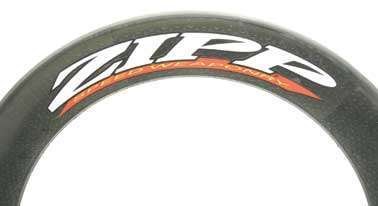
Comparons maintenant par exemple deux roues ayant le même nombre de rayons avant; la Cosmic Carbone SL et la Tune Olympic Gold. La différence de puissance absorbée provient principalement de la
différence de jante; une hauteur de 52mm pour la Mavic contre 46mm pour la Tune permet à la Française d’être plus rapide. Les rayons sont différents aussi et jouent certainement aussi un rôle
important dans la différence.
En gros, les exploitations aérodynamiques suivent logiquement les résultats de cet ancien article.
Protocole: la roue est placée sur un banc d’essai qualifié d’indéformable au vu des contraintes appliquées à la roue. Elle subit des
déformations latérale en fonction d’un poids connu (N). Ces déformations sont mesurées(mm) et la rigidité est ensuite traduite(N/mm).
En premier, exploitons les résultats de rigidité des roues avant:
| Modèle de roue | Rigidité roue avant (N/mm) |
|
|
|
| Lightweight Obermayer | 78,3 |
| Gipiemme Carbon 5-5 | 68,3 |
| Bontrager Race X Lite Carbon Aero | 67,41 |
| Ambrosio X Carbo | 65,2 |
| Corima Aero | 65,2 |
| CKT Splendor | 64 |
| Easton Tempest II Carbon | 60,9 |
| Mavic Cosmic Carbone SL | 58,7 |
| Citec 30005 aero | 55,3 |
| Zipp 808. | 52,9 |
| Campagnolo Bora G3 | 52,5 |
| Xentis mark1 | 39,8 |
| Ritchey WCS Carbon | 37,4 |
| Tune Olympic Gold | 37 |
La roue avant la plus rigide est donc la Lightweight Obermayer, elle est loin devant le peloton des autres roues, preuve que les grandes joues très rigides sont efficaces.
La corima aéro et la Ambrosio x-carbo ont des rigidité équivalentes alors que la française n’a que 18 rayons contre 28 pour l’Italienne lacés à un moyeu à grande joues. Les jantes sont
identiques pourtant, elles sont fabriquées par Corima, étrange phénomène qui se passe ici puisque les 10 rayons de plus de la Ambrosio devraient jouer en sa faveur, peut être que le moyeu a
grandes joues ne joue pas pleinement son rôle. En fait, les rayons de la Ambrosio ont leur têtes à l’extérieur ce qui diminue fortement la rigidité! Les tensions sont sans doute aussi
différentes. Il est aussi possible que la qualité du montage Ambrosio ne soit pas excellente…
Les roues Ritchey et Easton bénéficiant d’une jante identique ont pourtant une rigidité très différente. 60,9 contre 37,4N/mm à l’avantage de la Easton. Il n’y a que deux rayons de plus sur la
Easton, la différence ne peut pas provenir complétement des rayons, en examinant de près les moyeux, on s’aperçoit que les distances « centre de roue/ flasque de moyeux » des Easton sont
plus important. Le parapluie est donc plus grand et permet de gagner beaucoup de rigidité.
Maintenant les résultats des roues arrières:
| Modèle de roue | Rigidité roue arrière (N/mm) |
|
|
|
| Citec 30005 aero | 55,9 |
| CKT Splendor | 54 |
| Mavic Cosmic Carbone SL | 52,8 |
| Gipiemme Carbon 5-5 | 48,2 |
| Easton Tempest II Carbon | 46,1 |
| Campagnolo Bora G3 | 44,1 |
| Bontrager Race X Lite Carbon Aero | 43,8 |
| Zipp 808. | 40,7 |
| Ambrosio X Carbo | 39,7 |
| Corima Aero | 37,7 |
| Lightweight Obermayer | 37,1 |
| Xentis mark1 | 37 |
| Tune Olympic Gold | 32,6 |
| Ritchey WCS Carbon | 31,9 |
Constatation principale; les roues avant sont plus rigides que les roues arrières. Logique puisque la roue avant est parfaitement symétrique et bénéficie d’un double parapluie souvent important
contrairement à la roue arrière dont le parapluie droit est très faible.
Première grosse surprise; les Lightweight pourtant annoncées depuis longtemps comme très rigides sont en queue de peloton. La roue avant est même plus de deux fois plus rigide que la roue
arrière. Le faible parapluie de la roue est sans doute la principale cause, l’axe carbone est peut être la seconde.
La Cosmic Carbone SL ne trahit pas sa réputation de roue très rigide puisqu’elle est parmi les meilleures.
Les Easton et Ritchey quant à elles ont encore des rigidités très différentes; le concept d’équilibre des parapluies de chez Ritchey est apparement loin d’être au point quand on teste la
rigidité. Bien sur il permet d’obtenir une roue normalement très fiable car équilibrée presque comme une roue avant mais niveau rigidité, la roue bouge beaucoup à cause d’un parapluie gauche
faible contrairement à la Easton.
Puisqu’une paire de roues est rarement dissociée, j’ai décidé d’ajouter les rigidités des deux roues pour comparer la rigidité totale de la paire. Pas très intéressant à exploiter mais
permet une vue globale des paires:
| Modèle de roue | Rigidité totale (avant+arrière) (N/mm) |
|
|
|
|
|
|
| CKT Splendor | 118 |
| Gipiemme Carbon 5-5 | 116,5 |
| Lightweight Obermayer | 115,4 |
| Mavic Cosmic Carbone SL | 111,5 |
| Bontrager Race X Lite Carbon Aero | 111,21 |
| Citec 30005 aero | 111,2 |
| Easton Tempest II Carbon | 107 |
| Ambrosio X Carbo | 104,9 |
| Corima Aero | 102,9 |
| Campagnolo Bora G3 | 96,6 |
| Zipp 808. | 93,6 |
| Xentis mark1 | 76,8 |
| Tune Olympic Gold | 69,6 |
| Ritchey WCS Carbon | 69,3 |
Ce tableau ne reflète en aucun cas la rigidité des roues puisque de grosses variation existent souvent entre la roue avant et la roue arrière. (cf Lightweight)
Exploitation des résultats des moments d’inertie.
Le moment d’inertie représente la résistance de la roue a voir changer son état.
Ainsi, quand vous voulez augmenter votre vitesse, plus le moment d’inertie est élevé, plus la roue sera difficile a accélérer. Inversement, moins le moment d’inertie est élevé, plus facile sera la
roue à accélérer.
Mais on peut interpréter différemment le moment d’inertie; plus le moment d’inertie est élevé, plus difficile sera la roue à ralentir et inversement.
Le moment d’inertie d’une roue est beaucoup plus important que le poids d’une roue pour la qualifier.
C’est pour ça qu’une roue a fort moment d’inertie est très bien pour rouler à une vitesse de croisière qui varie très peu tandis qu’un moment d’inertie faible facilitera les changements de
rythme.
Habituellement le moment d’inertie est exprimé en gr/mm² mais dans ce test, ils ont préféré l’exprimer en Joules ce qui ne change rien à l’ordre des résultats.
| Modèle de roue | Moments d’inertie (Joules) |
|
|
|
| Lightweight Obermayer | 84 |
| Tune Olympic Gold | 88 |
| Ritchey WCS Carbon | 97 |
| Easton Tempest II Carbon | 101 |
| Xentis mark1 | 103 |
| Campagnolo Bora G3 | 103 |
| Bontrager Race X Lite Carbon Aero | 105 |
| Corima Aero | 106 |
| Zipp 808. | 107 |
| Ambrosio X Carbo | 114 |
| CKT Splendor | 115 |
| Citec 30005 aero | 129 |
| Mavic Cosmic Carbone SL | 143 |
| Gipiemme Carbon 5-5 | 148 |
On peut clairement scinder ce tableau en deux parties distinctes; les roues avec un moment d’inertie au dessus de 110 et celles inférieures à 110 Joules.
Les roues les plus lourdes en périphérie comme les Gipiemme et les Cosmic Carbone par exemple seront donc excellentes pour les sorties/courses très rapides avec peu de relances tandis qu’elles
accuseront le pas lors des montées ou des changements de rythmes en réclamant plus d’énergie que les autres.
On constate que les Ritchey et les Easton ont un moment d’inertie quasi similaire du à la même jante. La faible différence venant d’un nombre de rayons différents.
Les Lightweight Obermayer avec leur jantes à 300gr et les Tune Olympic Gold avec leurs jantes X-treme profilées à 315gr (réels mais annoncées à 295gr) occupent le peloton de tête.
Il serait très intéressant de tester les roues Bontrager disposant des jantes OCLV55 à 220gr. je serais curieux de voir le résultat. Une valeur de 60/65 joules ne m’étonnerait pas.
Après tous ces chiffres bruts, il est judicieux de s’attarder sur des rapports qui caractérisent tel ou tel type de roue.
Pour un tel effort individuel, un moment d’inertie élevé aidera à conserver une vitesse élevée tandis que l’aérodynamique doit être le meilleur possible pour pénétrer le mieux dans le flux d’air.
Donc le rapport moment d’inertie/aéro sera déterminé en divisant le moment d’inertie par la puissance absorbées par la paire de roues à 50km/h. Au vu des résultats pas très parlants, je décide de
multiplier toutes les valeurs trouvées par 15,3139… valeur qui correspond au facteur nécessaire pour faire passer la meilleure paire de roue de son chiffre brut à 100. Ainsi les résultats sont
plus exploitables car rapportés à 100 pour la meilleure roue, les autres roues ayant forcément une valeur inférieure à 100.
| Modèle de roue | Rapport (moment d’inertie/puissance absorbée à 50km/h) |
|
|
|
| Mavic Cosmic Carbone SL | 100 |
| Gipiemme Carbon 5-5 | 94,04 |
| Zipp 808. | 90,53 |
| CKT Splendor | 81,16 |
| Citec 30005 aero | 77,47 |
| Ritchey WCS Carbon | 76,97 |
| Easton Tempest II Carbon | 71,61 |
| Bontrager Race X Lite Carbon Aero | 68,72 |
| Campagnolo Bora G3 | 68,58 |
| Corima Aero | 65,72 |
| Xentis mark1 | 63,09 |
| Tune Olympic Gold | 55,92 |
| Ambrosio X Carbo | 55,42 |
| Lightweight Obermayer | 51,87 |
Ce classement reflète donc les roues les plus adaptées pour les parcours plats avec peu de relances.
Les Mavic Cosmic Carbone sont logiquement en tête du classement; très lourdes en périphérie et disposant d’un aérodynamique assez bon, elles s’imposent aisément.
La surprise vient des Zipp 808, elles ont un moment d’inertie assez bas comparé aux Cosmic Carbone par exemple et pourtant elles sont presque aussi efficaces que ces dernières grâce à leur
aérodynamique très pointu.
La déception des Lightweight est grande… très légéres en périphérie des qualités aérodynamiques pas si bonne que ça (bien que leur site veuille faire penser l’inverse) les placent en queue de
peloton.
En grimpant, le cycliste est souvent en danseuse pour bénéficier de pics de puissance plus importants afin de ne pas rester planté à la route (sera développé dans un article prochain) et
stresse la roue latéralement plus qu’en restant assis. La rigidité doit donc être la plus importante possible tandis que le moment d’inertie devra être le plus faible puisque grimper équivaut à une
succéssion de petites accélérations à chaque coup de pédale. Pour déterminer ce rapport, je vais donc diviser la rigidité par le moment d’inertie en multipliant le tout par un facteur pour que la
meilleure roue ait une valeur de 100. (comme précedemment)
Les valeurs des moments d’inertie bruts des roues correspondent à la paire de roue. J’utiliserai cette valeur pour calculer les rapports des roues avant et
arrière. Il s’agit donc d’une approximation mais elle est très faible étant donné que les paires de roues utilisent les mêmes jantes avant et arrière. Le moment d’inertie d’une roue étant à
presque 80% causé par la jante quand le boyau n’est pas en place et presque 50% quand le boyau ou le pneu est installés (téléchargez ce fichier ), on peut presque affirmer que le moment d’inertie de la roue avant ou arrière est la moitié du moment d’inertie de la
paire de roues. Imaginons que le moment d’inertie soit de 100 pour la paire, on peut dire que la roue avant et arrière auront presque un moment d’inertie égal à 50.
J’ai l’impression de mal m’exprimer… si vous ne comprenez pas, n’hésitez pas à me contacter.
Roues avants:
| Modèle de roue | Rapport rigidité roue avant/moment d’inertie |
|
|
|
| Lightweight Obermayer | 100 |
| Bontrager Race X Lite Carbon Aero | 69 |
| Corima Aero | 66 |
| Easton Tempest II Carbon | 65 |
| Ambrosio X Carbo | 61 |
| CKT Splendor | 60 |
| Campagnolo Bora G3 | 55 |
| Zipp 808. | 53 |
| Gipiemme Carbon 5-5 | 50 |
| Citec 30005 aero | 46 |
| Tune Olympic Gold | 45 |
| Mavic Cosmic Carbone SL | 44 |
| Xentis mark1 | 42 |
| Ritchey WCS Carbon | 41 |
La roue Lightweight Obermayer est logiquement au dessus du lot, bénéficiant d’une rigidité bien plus importante que les autres et d’un moment d’inertie très faible, elle est facilement en tête du
classement.
La ritchey est la plus mauvaise dans ce classement car sa faible rigidité ne l’avantage pas. Ritchey aurait du mettre les têtes de rayons à l’intérieur pour augmenter la taille du parapluie.
Roues arrières:
| Modèle de roue | Rapport rigidité roue arrière/moment d’inertie |
|
|
|
| CKT Splendor | 100 |
| Easton Tempest II Carbon | 97 |
| Lightweight Obermayer | 94 |
| Citec 30005 aero | 92 |
| Campagnolo Bora G3 | 91 |
| Bontrager Race X Lite Carbon Aero | 89 |
| Zipp 808. | 81 |
| Tune Olympic Gold | 79 |
| Mavic Cosmic Carbone SL | 79 |
| Xentis mark1 | 76 |
| Corima Aero | 76 |
| Ambrosio X Carbo | 74 |
| Ritchey WCS Carbon | 70 |
| Gipiemme Carbon 5-5 | 58 |
La CKT prend la tête dans ce classement ce qui est surprenant sur le papier. Pourtant en voyant les résultats des tests, il est logique qu’elle soit très bien placée.
La Easton est à mon avis la meilleure de ce comparatif car son moment d’inertie est bien plus faible que celui de la CKT, la rigidité étant juste un peu plus faible.
Les Lightweight tirent leur épingle du jeu grâce à un moment d’inertie très bas qui compense la faible rigidité de la roue arrière.
Dans ce test, toutes les jantes des roues ont au moins un profil moyen, ce ne sont pas des roues de montagne à part les Lightweight et les TUNE. Dans un rapport de ce genre de vraies roues légéres
de montagne auraient sans doute écrasé toutes ces roues. Je pense notamment aux Reynolds Cirro KOM ou aux Zipp 250.

TOUR; l’un des plus grand magasine allemand a publié pour le mois de Septembre un fantastique comparatif de roues.
Quatorze paires de roues ont été testées sur les points les plus importants.
Ce test fait penser aux excellents comparatifs de roues réalisés par Le cycle il y a quelques années.
Le tests ont donc été axés principalement sur la rigidité des roues, leur aérodynamisme et leur moment d’inertie qui sont les trois critères les plus importants d’une roue.
Les protocoles sont exactement identiques pour chaque roues, on peut donc aisément comparer les qualités de chacunes d’entre elles.
Voici donc les chiffres bruts:
Bontrager Race X-Lite Aero
Prix: 1400€Campagnolo Bora G3
Prix: 2300€
Citec 3000s aero
CKT Splendor
Prix: 1089€Corima Aero
Prix: 808€Easton Tempest II Carbon
Prix: 1700€Gipiemme Carbon 5.5
Prix: 1199€Lightweight Obermayer
Prix: 3690€Mavic Cosmic Carbone SL
Prix: 1250€Ritchey WCS Carbon
Prix: 1868€Tune Olympic Gold
Prix: 1583€Xentis Mark 1
Prix: 1718€Zipp 808
Prix: 1960€
Deux paires de roues sont quasiment identiques; il s’agit des Easton et des Ritchey qui bénéficient des mêmes jantes. Je m’efforcerait donc de comparer ces deux paires de roues en
priorité.

|
German magasine Tour, november edition, has been released. They tested the three best wheelsets of the world. Lew Racing, Lightweight Standard Generation 3 and the Mavic Cosmic Carbone Ultimate are in this test. The results are very interesting and the Lew wheels, although being super light, were amazingly stiff and fast. Here are their test results: |
| LewRacing Pro VT-1 | Lightweight Standard III | Mavic Cosmic Carbon Ultimate | |
| Price per pair (germany): | 4,499 Eur | 2,750 Eur | 2,300 Eur |
| Spokes front – rear | 16/20 | 20/20 | 20/20 |
| Testing values | |||
| Aerodynamics (30/40/50km/h): | 5.1/12.0/23.4 W | 5.3/12.6/24.6 W | 4.9/11.7/22.9 W |
| Moment of inertia: | 77 J | 87 J | 95 J |
| Front stiffness: | 45 N/mm | 72 N/mm | 55 N/mm |
| Rear stiffness: | 50 N/mm | 49 N/mm | 59 N/mm |
| Rim (width x height): | 20 x 46 mm | 20 x 53 mm | 21 x 40 mm |
| Weight front – rear – pair: |
370 – 529 – 899g |
483 – 620 –1103g |
512 – 693 – 1205g |
| Weight limit: | 85 kg (Clydesdale version available also) | 110 kg | none |
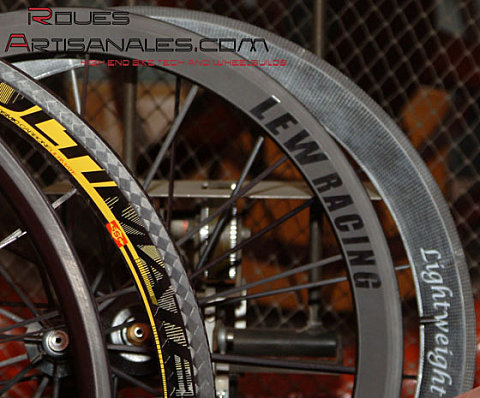 |
|||
|
Since the magasine in the newspaper kiosk, go ahead and buy it if you are close from the border or simply suscribe.
The super light weight wheels Lew Racing performed very well in this test and won a few days ago their first UCI classic in Australia: |
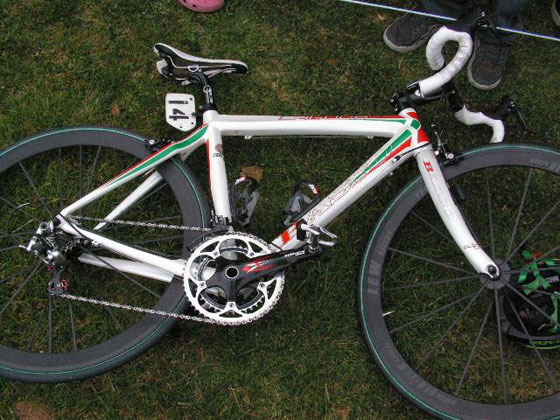

There’s today many beaten records, here are the world’s fastest downhill wheels;
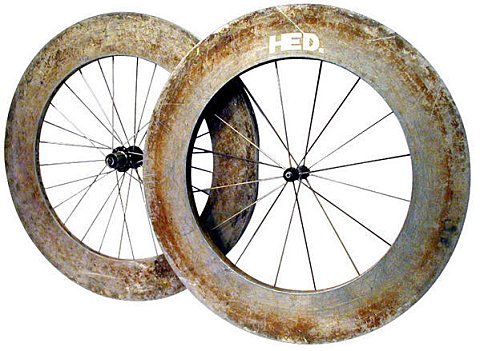
Source: Velonews

After the exclusivity some months ago about the world’s lightest road bike wheels ever built ( link ), here is the presentation of the lightest MTB wheels.
Still on purpose to mount a bike that will reaches the reasonables weights limits ( M2Racer project), Fairwheelbikes shop got the Extralite Ultraterra Ti weels (1135gr) then drills the rim. The weight after this procedure was 1117gr. The hubs are serials ones from Extralite; the Ultra hubs. Laced with 28 radials titanium spokes on the front and the rear non drive side, the rear drive side is two times crossed.
Toujours dans le but de réaliser un vélo qui atteindra les limites raisonnables du poids (projet M2Racer, le magasin Fairwheelbikes.com s’est procuré les roues Extralite Ultraterra Ti (1135gr) et a perçé la jante afin d’amener le poids à 1117gr. Les moyeux sont ceux de série de chez Extralite; les Ultra hubs. Dotées d’un rayonnage 28/28, elles ont un rayonnage titane radial à l’avant et à l’arrière côté opposé roue libre tandis que le côté cassette est croisé à 2.
Front wheel:
Rear wheel:
Weight: 615,5gr
The pictures was taken with a 2,3gr tape already installed.

En exclusivité pour Rouesartisanales.com, le célébre magasin américain Fairwheelbikes.com a fourni les photos des roues qui équiperont le projet du vélo le plus léger du monde de 2005.
A l’origine, l’équipe a travaillé sur ce projet pour monter une paire de roues à moins de 800gr… des moyeux ultra légers, des rayons titanes, des écrous carbone et des jantes exclusives qui n’existent qu’en quelques exemplaires sur la planète, tout était fait pour obtenir une paire à moins de 0,8kg.
Malheuresement une des jantes a eu un problème et a du être remplacée par un modèle plus lourd. Certes c’est toujours dans le domaine du hyper léger mais la paire ne passera pas la barre mythique des 800gr.
En bref, les jantes étaient fabriquées par la compagnie américaine Lew rachetée par Reynolds et ne sont bien entendu pas disponibles au détail.
La jante avant pèse 199gr et n’est donc plus fabriquée, il s’agit d’un des premiers prototypes qui franchissait les 200gr.
La jante arrière aurait du être du même type que celle prévue pour la roue avant mais elle fût finalement remplacée par un modèle un peu plus lourd; 223gr.
Le moyeu avant est le célébre BTP à 40,8gr (après petite modif) tandis que celui arrière et un prototype de TUNE qui pèse 156,5gr et qui inaugure peut être la nouvelle série de moyeu Mag150.
Les rayons sont en titane pour 185,5gr tandis que les écrous sont en composite pour dépasser de justesse les 10gr.
En ce qui concerne le montage, hors de question de croiser côté opposé roue libre et encore moins à l’avant; gain de poids oblige… Seul l’arrière côté roue libre est croisé à 2.
Jantes avant et arrière:
Moyeux avant et arrière:
Rayons et écrous:
La paire de roues montées atteint donc 817gr ( 331,5gr et 485,5gr).
Il s’agit de la paire de roues la plus légére jamais montée!!!
N’oublions pas que si une des jantes de moins de 200gr n’avait pas eu de problème, la paire aurait franchit la barre des 800gr…
La paire:
Retrouvez les photos dans CET album.
Originally, the team worked on this project to build a sub 800gr wheelset… ultra lights hubs, titans spokes, carbons nipples, exclusives rims which exists only as a few exemplary on the planet, everythings were done to get a sub 0,8kg set.
Unfortunately, one of the rim had a problem and had to be replaced by a heavier one.
It’s still incredibly light but the set won’t cross the mythical 800gr.
Shortly, the rims were made by Lew the american company now know as Reynolds and are of course not available as part.
The front rim weights 199gr and is not made anymore, it’s one of the first sub 200gr prototype.
The rear rim should have been the same kind of rim as foreseen for the front wheel but it was finally replaced by a heavier rim; 223gr.
The front hub is the famous BTP carbon hub at 40,8gr (after small modification) while the rear one is a prototype made by TUNE for 156,5gr which perhaps introduces the new Mag150 series.
Spokes are made in the titan material for 185,5gr while the nipples are composites ones to cross a bit the 10gr.
About the build, no way to cross on the non drive side and even less at the front; weight saves of course… Only the rear drive side is two times crossed.
Front and rear rims:
Front and rear hubs:
Spokes and nipples:
So the wheels built weight 817gr (331,5gr and 485,5gr).
Well it is the lightest wheelset ever built!!!
We mustn’t forget that if one of the sub 200gr rim wouldn’t have failed, the set would be under the 800gr…
The set:
You can find the pictures in THIS album.
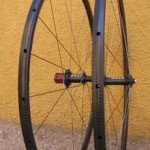
Nos cousins américains ont eux aussi leurs salon du jouet à domicile.
Implanté au milieu du désert du Nevada, l’Interbike accueille beaucoup de marques américaines qui n’ont pas pu faire le déplacement en Europe pour l’Eurobike. Lundi et Mardi étaient pour les journées d’essais, les trois jours suivants pour le salon à proprement parler. Continuer la lecture

Lew Pro VC-1 2009
La révolution…? SUITE
The revolution…? MORE
Rotor Q-Rings
Et toi, tu pédales comment? SUITE 
And you, how do you pedal? MORE:
Michelin Pro 3 race
1ère partie: présentation du premier bi-gomme route. SUITE
1st part: presentation of the first dual-compound tire. MORE 
Fibre-Lyte, transmissions carbone || Carbon transmissions
1ère partie: présentation; SUITE:
1st part: presentation; CONTINUE: 
2ème partie: 1er test; SUITE: 
2nd part: 1st test; CONTINUE: 
3ème partie: suite du test; SUITE: 
3rd part: next part of the test; CONTINUE: 

4ème partie: sur la durée… SUITE 
4th part: what’s with the kilometers… MORE 
Sram RED – Cassette
Vue rapprochée… SUITE 
Close view… MORE 
Lew Racing Pro VT1 (840g)
1ère partie: Pourquoi sont-elles si attrayantes? SUITE: 
1st part: Why are they so attractive? CONTINUE: 
2ème partie: sortie avec les anges SUITE 
2nd part: a ride with the angels MORE 
Lightweight Generation 3 (990g)
Revenues aux petits oignons… SUITE: 
Browned with onions… MORE 
Shimano 7850 C24 & C50 TU (1246g & 1489g)
Vues à la loupe! SUITE: 
Checked with a magnifying glass! MORE 
Speedcomposites Sinus 2007 (1002 gr)
Des roues à décrouvrir; SUITE: 
A wheelset to know; CONTINUE: 
Du nouveau! SUITE: 
Some news! CONTINUE: 
Mavic Cosmic Carbone Ultimate (1190g)
1ère partie: Que peut-on en penser? SUITE: 
1st part: What can we think about them? CONTINUE: 
Mavic R-SYS! (1355g)
1ère partie: Un système révolutionnaire! SUITE: 
1st part: A revolution! CONTINUE: 
2ème partie: Les sensations sur la route… a suivre
2nd part: how they feel on the road… to follow
Lightweight Obermayer Generation II (922g)
Outstanding Lightweight Obermayer II ! CONTINUE: 
Formidables ces Lightweight Obermayer II! SUITE: 
2ème partie: Le comportement sur la route… a suivre
2nd part: the behaviour on the road… to follow
Patins de freins || Brake pads
Swissstop, présentation: SUITE: 
Swissstop presentation: CONTINUE: 
Corima, présentation: SUITE: 
Corima presentation: CONTINUE: 
Powercordz
1ère partie: Un système de câbles très spécial; SUITE: 
1st part: A very special cable system; CONTINUE: 
2ème partie: Comment les installer? SUITE: 
2nd part: How to install them? CONTINUE: 
Comparatif attaches rapides || Quick releases comparative
Quelques attaches faciles à trouver: SUITE: 
Some easy to find quick releases; CONTINUE: 
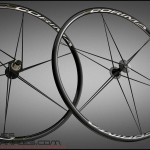
If you follow our articles since a long time, you probably realized the wheel market is deeply changing since a few years and the french manufacturers are not trivial to it. Continuer la lecture
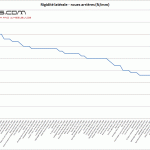
 Photo by Alessandro Trovati
Photo by Alessandro Trovati
Avec pas mal de retard, nous publions enfin la troisième partie du grand test de roues 2008: celle qui traite donc de leurs rigidités, notions aussi floues que compliquées. Continuer la lecture

|
Tests de pédaliers
Les mesures de déformation des pédaliers sont prises à trois points distincts, importants dans le fonctionnement des manivelles et représentatifs de la rigidité de l’ensemble. Les tests de déformation sont ensuite effectués en ajoutant une charge de 90kg, pour chaque manivelle. La déformation du plateau est aussi enregistrée, elle n’est pas très importante mais Pour faire court, les manivelles des grands constructeurs s’avèrent toutes très rigides et les diffèrences se jouent dans un mouchoir de poche, en tout cas pour les meilleurs pédaliers. Le
Nous vous invitons à jeter un coup d’oeil au forum FairWheelbikes. Scott 2009 – suite Nous vous avions présenté les nouveaux Scott il y a quelques semaines. Seul le Plasma est réellement renouvellé: le cadre atypique est taillé pour la vitesse avec notamment un appendice Voici donc quelques photos. Merci à Cycles Dubreucq à Le Quesne au Leu pour les photos du Plasma et du cadre de Cross.
|

|
Crankset test
The deformations of the cranksets are measured at three different places, important in the functionning and representative of the overall stiffness. The deformation tests are performed with an extra load of 200lbs, on each crank arms. The chainring deformation is saved too, it is not very important but it may be useful for riders having Briefly, the cranksets of the biggest manufacturers are all very stiff, and the differences between the formers are pretty small. The Sram Red is getting the best of this test, the FSA SL-K
We invit you to visit the FairWheelbikes forum. Scott 2009 – second part We presented the newest Scott frames some weeks ago. Only the Plasma is really renewed. It is a very special frame with an appendix under the bottom bracket, bi-directionnal chainstays, and Here are some pictures. Thanks to Cycles Dubreucq at Le Quesne au Leu for the pictures of the Plasma and the cross frame.
|

|
Here is the last article about the Campagnolo 2009 news. We unveiled into the details the 11s groupsets and the gorgeous Super Record a few days ago, now let’s see what the italian manufacturer has developped regarding the wheels. Clincher/Tubeless First of all, the two high range aluminium wheels feature the Two-way Fit technology: they accept both the clincher and tubeless tires. According to Campagnolo, there are a lot of The Shamal and Eurus 2009 wheels feature this new technology. Technically speaking, the rim is obviously not drilled, and the valve drilling received an appendix to prevent the pressure The Shamal Ultra Two-way fit weight 1450g and the Eurus Two-way 1550g. Basically, there is no difference, regarding the spokes and hubs, with the current 2008 versions.
Bora/Hyperon Ultra two The high range wheels do not receive dramatic modifications. Campagnolo is coming back to ceramic bearings here and the name is different: the Bora Ultra is now the Bora Ultra two.
|

Lew Pro VC-1 2009
La révolution…? SUITE

The revolution…? MORE

Michelin Pro 3 race
1ère partie: présentation du premier bi-gomme route. SUITE

1st part: presentation of the first dual-compound tire. MORE

Fibre-Lyte, transmissions carbone || Carbon transmissions
1ère partie: présentation; SUITE:

1st part: presentation; CONTINUE:

2ème partie: 1er test; SUITE:

2nd part: 1st test; CONTINUE:

3ème partie: suite du test; SUITE:

3rd part: next part of the test; CONTINUE:

4ème partie: sur la durée… SUITE

4th part: what’s with the kilometers… MORE

Sram RED – Cassette
Vue rapprochée… SUITE

Close view… MORE

Lew Racing Pro VT1 (840g)
1ère partie: Pourquoi sont-elles si attrayantes? SUITE:

1st part: Why are they so attractive? CONTINUE:

2ème partie: sortie avec les anges SUITE

2nd part: a ride with the angels MORE

Lightweight Generation 3 (990g)
Revenues aux petits oignons… SUITE:

Browned with onions… MORE

Shimano 7850 C24 & C50 TU (1246g & 1489g)
Vues à la loupe! SUITE:

Checked with a magnifying glass! MORE

Speedcomposites Sinus 2007 (1002 gr)
Des roues à décrouvrir; SUITE:

A wheelset to know; CONTINUE:

Du nouveau! SUITE:

Some news! CONTINUE:

Mavic Cosmic Carbone Ultimate (1190g)
1ère partie: Que peut-on en penser? SUITE:

1st part: What can we think about them? CONTINUE:

Mavic R-SYS! (1355g)
1ère partie: Un système révolutionnaire! SUITE:

1st part: A revolution! CONTINUE:

2ème partie: Les sensations sur la route… a suivre
2nd part: how they feel on the road… to follow
Lightweight Obermayer Generation II (922g)
Outstanding Lightweight Obermayer II ! CONTINUE:

Formidables ces Lightweight Obermayer II! SUITE:

2ème partie: Le comportement sur la route… a suivre
2nd part: the behaviour on the road… to follow
Patins de freins || Brake pads
Swissstop, présentation: SUITE:

Swissstop presentation: CONTINUE:

Corima, présentation: SUITE:

Corima presentation: CONTINUE:

Powercordz
1ère partie: Un système de câbles très spécial; SUITE:

1st part: A very special cable system; CONTINUE:

2ème partie: Comment les installer? SUITE:

2nd part: How to install them? CONTINUE:

Comparatif attaches rapides || Quick releases comparative
Quelques attaches faciles à trouver: SUITE:

Some easy to find quick releases; CONTINUE:


|
Taipei bicycle show Taïpei bicycle show took place in Taïwan during 4 days, from the 16th to the 19th of March. Although there were no interesting news, since the manufacturers prefer to feature their newest Rival levers Sram Rival levers will get a carbon structure for 2009. After most groupsets from Campagnolo Record, Chorus, Centaur, then Sram Red, and finally Shimano Dura-Ace for 2009 too, it’s Rival’s
Grammo wheels Do you remember the Grammo wheels we presented mid septembre 2007, a few days after the Eurobike where they were actually
Well, the wheels were obviously featured in Taïpei and they brought a lot of attention. Take a look at the picture below, you can see the very special spokes looking like everything but a
spoke! The associated tensiometer is a pure beauty.
Source: Orbea Orca 2009 Featured on Cyclingnews, the latest Orbéa Orca, which will be available for 2009, gets more muscle with 20% more stiffness thanks to different fibers and loses 10% of weight at the same
Photo ©: Ellis Bacon @ Cyclingnews
Roues Artisanales Lew/Tune/DT Aerolite The german website Light-bikes.de got a handbuilt wheelset from our hands to test and feature. With just 1039g the complete wheelset (1042 with some tubular glue), the Lew Racing Pro VT1 Roues artisanales test (in german).
Shimano Dura-Ace 2009 The french magasine L’Acheteur Cycliste has got very sharp pictures of the latest Shimano Dura-Ace 2009 mechanical groupset. The rear derailleur with the carbon shape is clearly visible,
|

Zero Gravity

Les freins Zero Gravity Negative G, dévoilés il y a quelques mois, sont fabriqués en édition limitée, couleur rouge: il paraît
Shimano propose depuis plusieurs semaines ses dernières roues 7850 C24 CL, la version pneu à jante carbone/aluminium, en test via les revendeurs à travers tout l’Europe. 2000 coureurs
Il semblerait que les résultats soient plutôt très encourageants, les notes descendant rarement sous le 3,5/5. Plus d’informations à partir de la page officielle: |
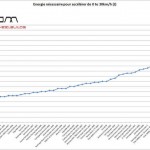
 Crédit photo : www.photos-dauphine.com
Crédit photo : www.photos-dauphine.com
Cette seconde partie traite de l’inertie des roues, caractéristique ô combien importante, qui entre dans les mœurs des cyclistes. L’évaluation des performances d’une paire de roues
passe forcément par son évaluation, même si son importance est somme toute relative sur l’ensemble coureur plus vélo. Continuer la lecture

30-09-2007 887g! Lew, M5/Extralite/Pillar
1422
Un montage d’exception: SUITE

An exceptionnal wheelbuild: MORE:





















AC350, DT240s, Cx-ray
Roues de course pneus passe partout; SUITE:

Versatile clincher race set; CONTINUE:



Wolber profil A, Spada, cx-ray
Des roues classiques sur des moyeux dernière génération;
Classic wheels on latest generation hubs; CONTINUE:

Zipp 250, Tune Mag160/AC, Dt aérolite
A peine plus du kilogramme!
Slightly more than a kilogramm! CONTINUE:

Montage/built Crono F20, Tune Mig70/Mag190, Cx-ray
Montage léger, très fiable et rigide;
Light, very reliable and stiff built; CONTINUE:

La paire de roues la plus légére! || The lightest wheelset ever!
Incroyable; SUITE:

Unbelievable; CONTINUE:

Montage/built Crono F20, Dura Ace 7800, Cx-ray
Un montage efficace et sobre,
An efficient and sober built; CONTINUE:

Corima Winium, TUNE Mig70/Mag190, Cx-ray
Un montage carbone très éfficace;
Very nice carbon rim built by David; CONTINUE:

Or10, FRM feather, Cx-ray
Ancienne jante avec un moyeu FRM carbone;
Vintage rim with high end FRM carbon hub; CONTINUE:

Zipp 280, DT240s, Cx-ray
De très bonnes roues, légères, assez rigides et fiables;
Very good wheels, light, quite stiff and reliables; CONTINUE:

Open Pro, Centaur, Dt compétition
Une roue arrière fiable et à tarif réduit
A cheap and reliable training rear wheel; CONTINUE:

Or7, Tune Mig66 & Mag190, Cx-ray
Un look rétro et un poids à faire palir les dernières roues!
A vintage look but a crazy light wheelset!
Roue avant
Front wheel; CONTINUE:

Roue arrière
Rear wheel; CONTINUE:

Argent10, FRM carbone, Cx-ray
Légéres, et très nerveuses. CONTINUE:

Light and very responsives.

Speedcomposites is a very special company. One man, knowledge, experience, production, and … the wheels. Lars, has
been making the rims and hubs himself in his workshop in Holland for a few years. This is a real quality and service label from a man consumed by his passion. Definitely unique in Europe and
probably the whole world, his 10 years of experience in designing aluminium and carbon components means he can produce all the key components.
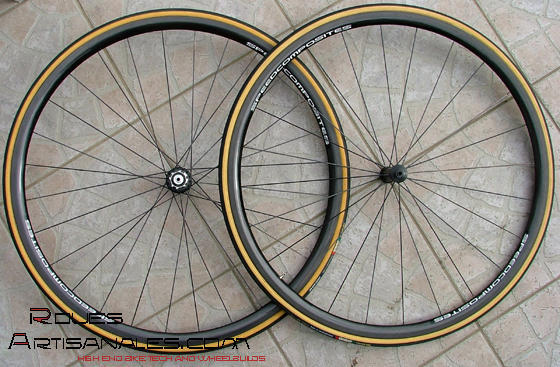
Performances of a number of world-class cross riders say a lot for the quality and strength of these wheels. Speedcomposites has become a reference in the road and cross domains.
We originally featured these wheels on RouesArtisanales about two years ago ( see here). The product has been continually improved since the first version. Since he does everything himself, Lars can make product
updates when he likes. A new rear hub with a special spoke
pattern was designed. It uses radial drive-side spokes and crossed non drive-side spokes to balance spoke tension. Sapim CX-Ray spokes lightened the wheels. Then improvements on the rims
reduced the weight without sacrificing strength. These changes brought weight down to 1002g in the CX-Ray 24/24 version.
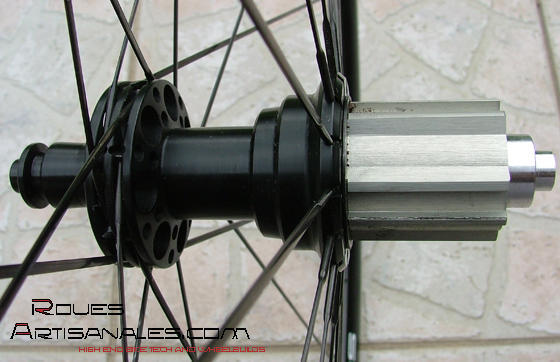
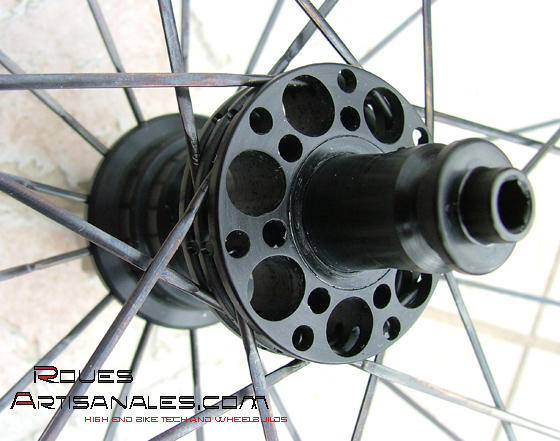
Recently, the quality of these hoops has been upgraded in a couple of areas:
The rims
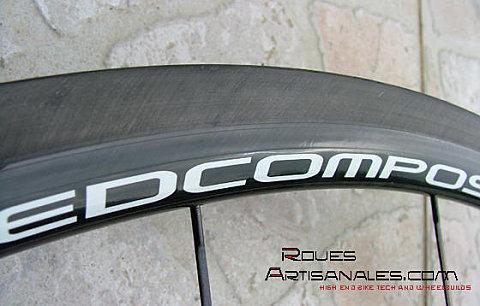
The rear hub
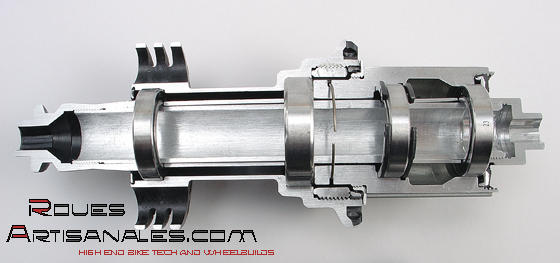
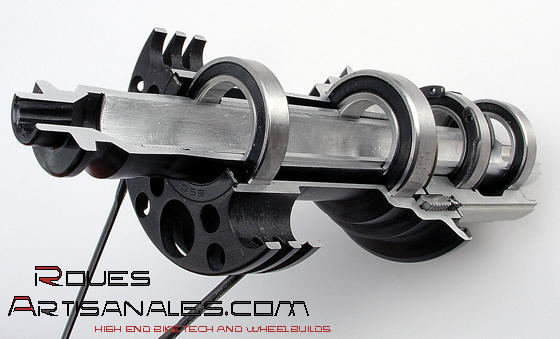
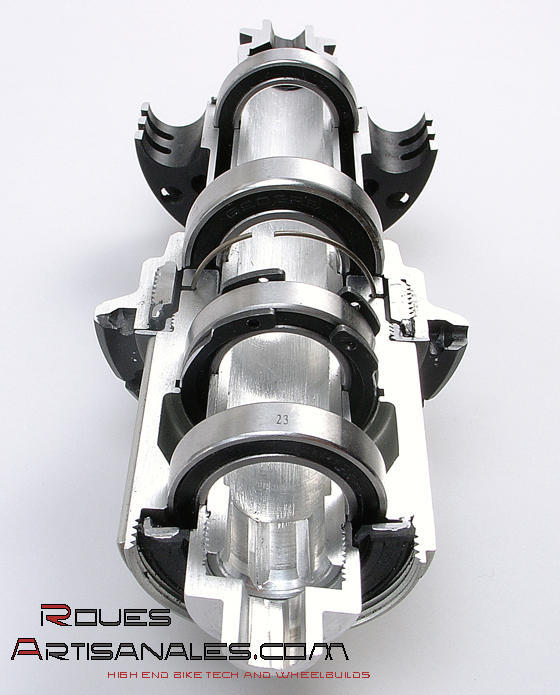
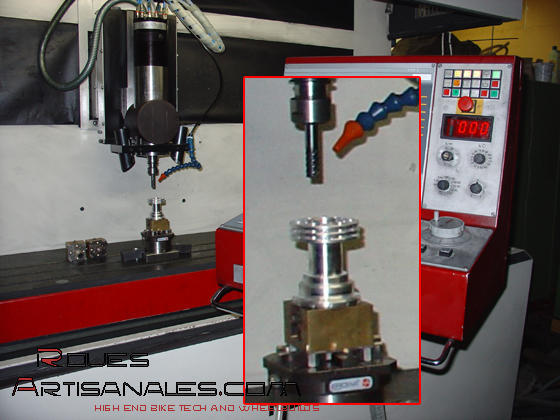
The wheels hit the scales at 1085g in 24/28 CX-Ray and reinforced rims for riders over 82kg. This weight is reached without any concession: the stiffness, reliability and dust/watertightness are
kept for harsh cyclo-cross conditions.
On the lighter versions, the rim weight comes down to 250g, sometimes less. The total weight of the wheelset in 20/24 Cx-ray is then around 1045g…
The wheels are currently €1139 with Laser spokes and €1198 with CX-Ray spokes. Prices have gone up since 2005 but are still incredibly low compared to competitors. The usual order turnaround is 4
weeks.
In short, Speedcomposites wheels are among the most interesting wheels on the market. The quality to price ratio is unbeatable and, everything is « made in house », meaning quality and
hard-lining.
That is why we chose these wheels for the test we will perform very soon. We hope for high stiffness and low inertia results!

This year, two new lightweight and high-end wheelsets hit the market, certainly to face up Carbon-Sports and Lightweight wheels supremacy. Lew Racing has announced on the 27th of January its Pro VT1 and Mavic, its Cosmic Carbon Ultimate the 15th of February. Both of them have serious assets related to the material, the technic, the service or the price to intimidate the well known and famous german brand.
Mavic simply modified Lightweight wheels’ Heinz Obermayer concept. There is a truing system on the rear wheel, differents shapes and materials for the hubs and the rims. The main process still remains the same: the spokes are laminated as one piece inside the rim and are wrapped around the hub. If a spoke is broken, the wheels are unusable, they can be put with the waste! They cost more than 2300 euros for the Mavic and 2600 or 3600 for the Lightweight Standard and Obermayer, the bill is quite high…
| Broken spoke around the hub notch | |
|
The advantage of Lew Racing wheels is about the possibility to replace any part of the wheel: the spokes, the hub or even the rim. This is possible thanks to the manufacturing process that is totally different from the two sets we spoke about above. Here, the spokes are bonded inside the notches of the hub and the rim via a specific agent. They provide the stiffness and the integrity of the wheel when the manufacturing process is ending. Indeed when a spoke has been damaged, Lew Racing removes it by heat, internal pressure and external force. A reactive agent is used to completely remove any trace of bonding product at the spoke/hub and spoke/rim interface. |
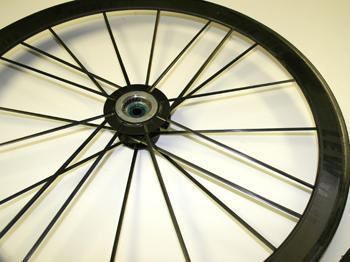
|
|
Repaired spoke
|
|
|
Then, a brand new spoke is replaced and bonded, just like it was destinated to a new wheel. |
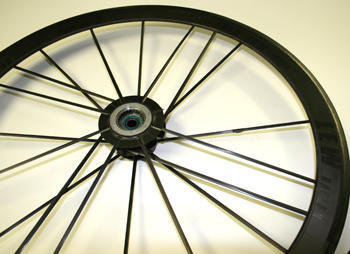
|
As comparizon, you can realize the differences between the three wheelsets thanks the following table:
| Lew Racing PRO VT1 | Lightweight Generation 2 | Mavic Cosmic Carbone Ultimate | |
| Rims | – 46mm deep – Carbon / Boron -230 g – swirl generator lip |
– 53mm deep -Carbon 3K – approximately 290-320g |
– 40mm deep – Carbon 12K – the rear is assymetrical |
| Spokes | -16 front / 20 rear – Carbon / Boron – NACA 0029 airfoil section (aeronautic comitee) – 3g |
– 12-16-20 front / 20 rear – Carbon / Kevlar |
– 20 front / 20 rear – Carbon – Truing and adjusting system on the non drive side of the rear wheel |
| Hubs | – Carbon / Boron – Rear hub has 3 flanges, the two exteriors for the stiffness and the cantral one to transfer the torque – boron axles, 15mm of diameter |
– Carbon 3K for both front and rear hubs – alloy front axle: 15mm of diameter, carbon rear axle: 15mm of diameter |
– Front is Carbon 12K – Rear is made out of alloy – alloy 9mm of diameter axles |
| Manufacturing process | Lamination / Bonding | Lamination / moulding | Lamination / moulding |
| Carbon brake pads | No | Yes | Yes |
| Wheelset weight | 880 to 920g (Shimano and Campagnolo versions) | 915 à 1090g (super light 12/20 Obermayer version and Standard 20/20 version) | 1185g |
| Service | Each part is serviceable, a 4 year "No question asked" warranty extension programm is available for a complete replacement. It costs US$1000 | The rims is sometimes reparaible. Otherwise, there is a 30% discount on a complete new wheel | MP3 extension programm warranty. Complete replacement under certain condition |
| Price | 4100 euros (5500 dollars) | From 2600 (3500 dollars) for the Standard to 3600 (5500 dollars) euros for the Obermayer | 2300 euros (2700 dollars) |
|
Click to enlarge |
 |
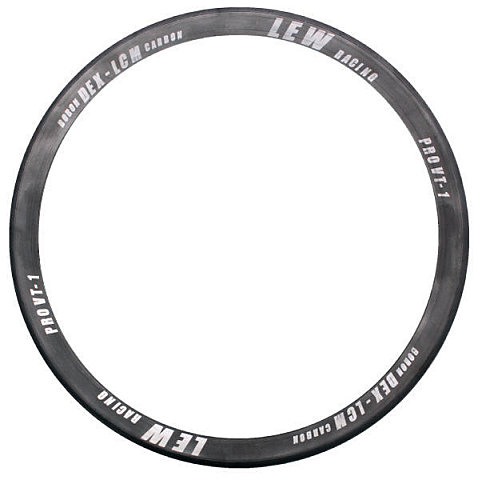 Click to enlarge |
|
– Torque transfer
Another interesting feature is about the rear hub. To transfer the torque, we usually cross the rear wheel spokes as much as we can to place them as tangential to the rear hub. Because of the bracing angle, they are not in the same plane as the rim and so they get useless stress. With this special design, the rear wheel has the advantages of both the high bracing angles bringing superior stiffness and the zero degree bracing angle providing the perfect torque transfer…
| Rear hub, triple flanged | |
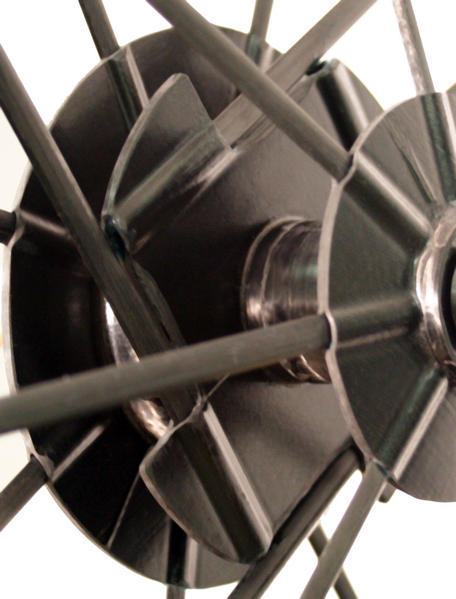
|
The rear hub is triple flanged: the two exterior ones are far from each other (60.61mm, Lightweight width is 58mm and Mavic CCU width is 55mm) and receive radial spokes for a maximal stiffness. The central one gets four spokes 25% oversized. They are tangential to the hub to transfer the torque generated by the rider. This flange is placed perfectly in the same plane as the rim to force the spokes working only in traction and to prevent them from bending. |
|
Click to enlarge
Photo ©: Fairwheelbikes.com
|
Click to enlarge
Photo ©: Fairwheelbikes.com
|
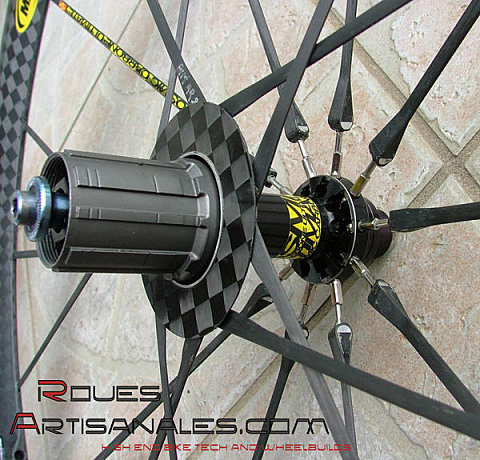 Click to enlarge
Photo ©: Fairwheelbikes.com
|
|
|
Click to enlarge
Photo ©: Fairwheelbikes.com
|
|
– An excellent stiffness, in theory
One thing is sure, thanks to several things, related to the architecture and the material used, in theory the wheels are very stiff. The distance between the flanges of the hub is high, it reduces the rim movements between the brake pads while accelerating. Then, the second reason for stiffness is due to the spokes. Fully inserted at the bottom of the hub and rim notches, they are then bonded inside their compartment. Five times as stiff as the traditionnal stainless steel spokes, they are as well three times more resistant to compression and double the tensile strength. These properties mixed to their full insertion at the bottom of the notches allow them to work both in compression and traction (Mavic isn’t innovator on this concept though). Thanks to this, even with very low spoke tensions the stiffness should remain high.
We are impatient to get the wheels to test them in laboratory…
– Weight, inertia & sturdiness
Beside all these features Paul Lew introduced on his wheels this year, the overall weight of the wheelset is between 880 and 920g… which is very low. This weight can be reached thanks to the carbon/boron material and the special DEX-LCM™ technique developped for the American department of defense. About the inertia, the Lew wheels rims weight only 230g while their height is 46mm. It means they should be incredibly easy to accelerate. As comparizon, Lightweight rims weight is between 290 and 320g.
Last but not least, the spoke tension in these wheels is very low. Therefore, even with a broken spoke, the wheel remains true, with no hoop nor big change in stiffness or behaviour. This is another breakthrough in wheel functionning…
| Interview of Paul Lew, engineer and designer of Lew Racing PRO VT1 (11,8Mb) |
Thus…
Paul Lew wheels definitely have an enormous advantage over the Lightweight wheels and Mavic CCU whose design is very efficient but is growing older and is almost impossible to repair.
Mavic, with its MP3 program replaces the Cosmic Carbon Ultimate for 185 euros. Carbon-Sports proposes a 30% discount on a new wheel. Here, for the Lew wheels there is only to remove the broken spoke then bond a new one… which is far cheaper than a complete replacement for both the customer and the company.
The only disadvatange of Lew wheels is that they are some hundreds extra euros!
| Rear hub disassembly (11.8Mb) |
| Rear hub assembly (7.18Mb) |
– Spoke magnet
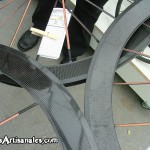
This year, our journey at Friedrischafen for the Eurobike earl in September has been unforgettable. Close to the Constance lake where the three countries Germany Austria and Switzerland meet. The Messe is just 72.000 square meters of exhibition, which was really big. It has been a dream for us to be there as journalists to report the news. It was a dream come true and we simply didn’t think we could see so many amazing things there. Not only had we the chance to see this exhibition but also the chance to mix with Carbon-Sports‘ fantastic guys who let us in on the secret of Lightweight wheels! Continuer la lecture

Almost a year after the first prototypes have been used on pro races, Shimano is doing that again with its Dura-Ace electric groupset that seems to follow a long test in order to validate the product in the best conditions.
Some design changings have been done to save some weight (for example on the rear derailleur) and make the whole group nicer.
Here are the pictures of the jowels used by Rabobank :
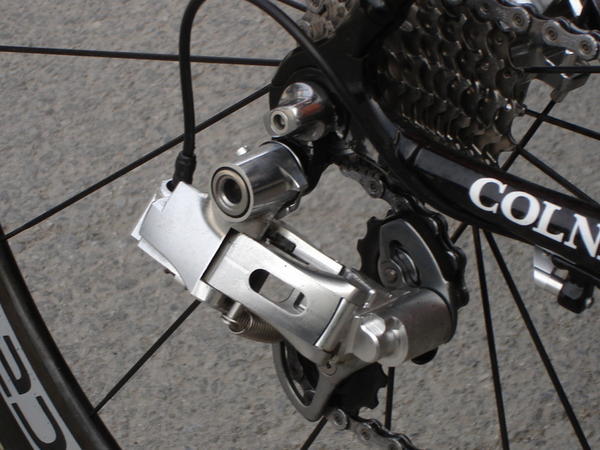

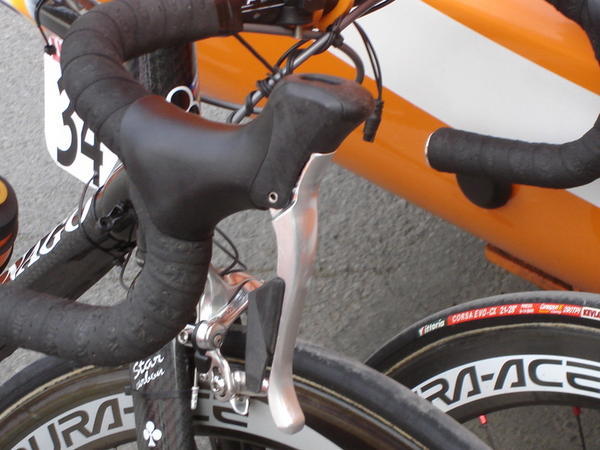
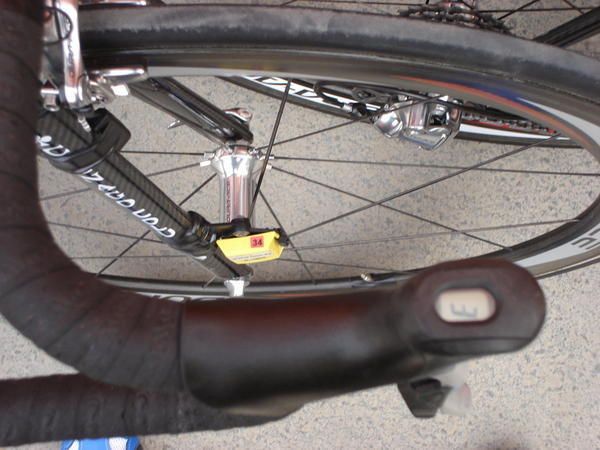
Previous Roues Artisanales.com articles: 1, 2, 3, 4
On the other side, Shimano worked as well on new wheelsets. Some new hubs with smaller but more distant flanges will reduce the total weight and increase the stiffness. These new versions, called 7850 have external red anodized nipples while the current models have hidden nipples.
Here are the tubular versions:
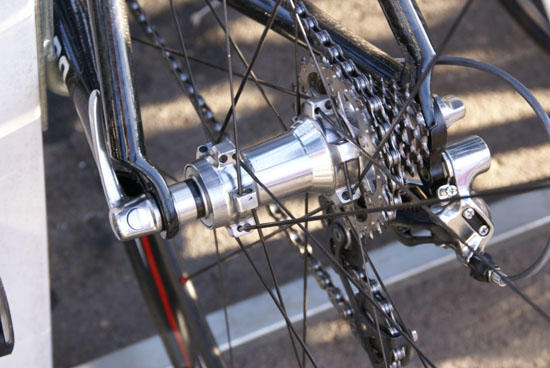
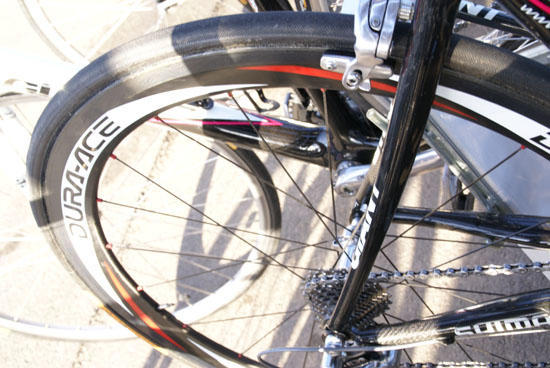
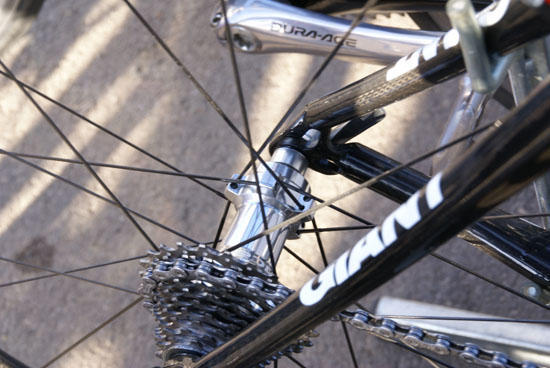
Photos by Adam Hansen.




The clincher version is more specific since the rims are partially made out of carbon. 1.2kg for these wheels that will be available from Septembre 2007.
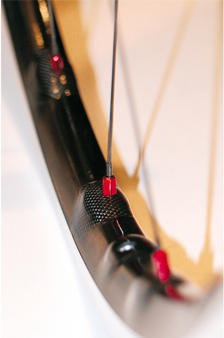
|
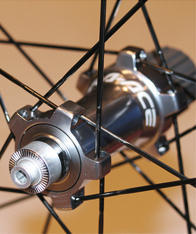
|
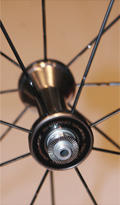
|
|

Lien grand test de roues version 2008
En aôut dernier nous avions été très heureux de décortiquer les tests de roues éffectués par le magasine allemand TOUR. Cette année ils ont récidivé avec des
modèles différents mais en gardant un protocole parfaitement identique pour assurer la reproductibilité des tests. Une base de donnée importante et de qualité est donc disponible et nous vous la
proposons ici. Les interprétations sont en plus en bas comme nous l’avions fait en 2005 (ici et ici).
Aérodynamisme: Aptitude de la roue à pénétrer l’air. Plus cette valeur est faible, meilleure sera la roue. Elle s’exprime en Watts absorbés à 30, 40
et 50km/h. On ne prendra en compte dans ce comparatif que celle absorbée à 50km/h.
Inertie: Aptitude de la roue à maintenir une vitesse. Plus la valeur est faible, plus facile sera la roue à changer de rythme (accélérations ou
freinages). A l’inverse plus cette valeur est élevée, plus la roue conservera sa vitesse. L’inertie d’une roue transcrit directement le comportement d’une roue, c’est une valeur plus importante que
le poids de la roue elle même . Elle s’exprime en Joules dans ce test mais normalement en gr/mm², voir protocole de mesure de l’inertie ci dessous pour en savoir plus.
Rigidité latérale: Aptitude de la roue à se déformer latéralement. Plus cette valeur est élevée, plus la roue sera inflexible à vous accoups de
pédalage et en virage, donc plus la roue sera rigide et meilleure pour transmettre l’énergie du coureur. Elle s’exprime en N/mm.
Poids limite: Valeur donnée par le constructeur comme poids limite à ne pas dépasser par l’utilisateur. Au dessus de cette limite les roues ne sont
pas conseillées et leur utilisation pourrait s’avérer dangereuse.
Protocoles (idem article de 2005):
Test d’aérodynamisme: le test a été effectué à l’université de Lyon. Le tunnel n’est pas fermé et a été optimisé pour les tests Mavic. Seules les
roues avant sont testées. La vitesse du vent est de 50km/h. Les forces du vent et celle nécessaire pour faire tourner la roue sont mesurées donc la traînée causée par la rotation de la roue elle
même est connue. L’aérodynamisme est testé à differents angles en tournant la roue de 0 à 15° par rapport à la direction du vent. La procédure de test est complétement automatisée. A chaque
position, trois valeurs sont prises en comptes et elles doivent être proches les unes des autres pour être valides.La courbe représente les données prises à une certaine vitesse.
Test d’inertie: la roue nue est suspendue par la jante et un aimant est ajouté à la roue. La roue est balancée et un compteur mesure la durée de la
période. Ce procédé est répété 3 fois, la moyenne est faite pour la roue avant et arrière puis est utilisée pour calculer l’énergie nécessaire pour accélérer le roue avec un pneumatique lambda
(identique pour toutes les roues) de 0 à 30km/h (voir cette page)
Test de rigidité latérale: Les roues sont montées sur un bâti grâce avec une attache rapide et sont contraintes par l’intermédiaire d’un câble sur
et entre les rayons. La force et la distance sont enregistrées par ordinateur. La rigidité minimale est prise en compte.
Résultats bruts année 2005 et 2006 par ordre
alphabétique:
| Modèle de roue | Aéro (W) | Inertie (J) |
Rigidité latérale avant / arrière (N/mm)
|
Poids limite (Kg) |
| Ambrosio X-Carbo | 31,5 | 114 | 65 / 40 | 90 |
| Bontrager Race X Lite Carbon aero | 23,4 | 105 | 67 / 44 | pas de limite |
| Campagnolo Eurus | 27,8 | 123 | 61 / 58 | 82 |
| Campagnolo Hyperon | 32,1 | 97 | 55 / 53 | 82 |
| Campagnolo Bora G3 | 23 | 103 | 53 / 44 | 82 |
| Citec 3000S | 30,6 | 127 | 57 / 56 | 99 |
| Citec 3000S Aero | 25,5 | 129 | 55 / 56 | 89 |
| CKT Splendor | 21,7 | 115 | 64 / 54 | 110 |
| Corima Aero | 24,7 | 106 | 65 / 38 | pas de limite |
| Corima Turbospoke | 23,1 | 111 | 34 / 34 | pas de limite |
| Easton Tempest II Carbon | 21,6 | 101 | 61 / 46 | pas de limite |
| FRM FL-R 23 SD Aerolight | 24,6 | 105 | 53 / 32 | pas de limite |
| FSA RD-600 | 28,7 | 124 | 40 / 33 | pas de limite |
| Fulcrum Racing Speed | 23,7 | 102 | 55 / 42 | pas de limite |
| Gipiemme Carbon 5-5 | 24,1 | 148 | 68 / 40 | 120 |
| HED Hed 3 | 19,7 | 129 | 36 / 35 | 100 |
| Lightweight Obermayer | 24,8 | 84 | 78 / 57 | 80 |
| Lightweight Ventoux/Standard | 27,3 | 88 | 55 / 50 | pas de limite |
| Mavic Aksium Race | 30,0 | 143 | 74 / 48 | pas de limite |
| Mavic Ksyrium ES | 33,2 | 120 | 56 / 47 | pas de limite |
| Mavic Cosmic Carbone SL | 21,9 | 143 | 59 / 53 | 100 |
| Ritchey WCS Carbon | 19,3 | 97 | 37 / 32 | pas de limite |
| Rose Aerospoke | 23,0 | 165 | 33 / 29 | pas de limite |
| Shimano WH-7801 Carbon 50 | 22,9 | 110 | 78 / 51 | pas de limite |
| Shimano WH-7801 Carbon | 24,4 | 98 | 64 / 51 | pas de limite |
| Shimano WH-R560 | 26,1 | 132 | 58 / 48 | pas de limite |
| Tune Olympic Gold 2005 | 24,1 | 88 | 37 / 33 | 90 |
| Tune Skyline 2006 | 28,1 | 78 | 42 / 28 | 85 |
| Vuelta Carbon Pro WR | 20,8 | 108 | 46 / 30 | 100 |
| Xentis Mark 1 | 25 | 103 | 40 / 37 | pas de limite |
| Zipp 808 | 18,1 | 107 | 53 / 41 | pas de limite |
Graphiques des résultats bruts:
Aérodynamisme; roues avant classées de la plus rapide à la moins rapide.
Les roues Zipp 808 testées l’an dernier sont toujours les premières de ce comparatif. Il sera très difficile de les détrôner puisque que la jante de 82mm de hauteur associée aux fossettes est très
efficace. Les roues Ritchey et Easton qui suivent utilisent les jantes Zipp 404 sans les fossettes et sont aussi très efficaces. Les HED à 3 bâtons et les Vuelta atypiques font parties du peloton
de tête tandis que la Corima Turbospoke (3 bâtons) et les Rose Aerospoke (4 bâtons) trâinent un peu la patte par rapport à des roues plus conventionnelles comme les Mavic Cosmic Carbone, les
Shimano Carbon 50mm ou les Campagnolo Bora G3. Preuve qu’une roue classique bien dessinée peut être plus rapide qu’une roue spécifique pour contre-la-montre.
Les Ksyrium ES sont très mauvaises comparées au gros de la troupe. Les rayons assez épais et la jante plate usinée ne font pas très bon ménage.
Globalement, sur ce graphique les jantes profilées sont logiquement en tête. Elles sont suivies par certaines roues que l’on peut qualifier de transitoires à partir des Citec 3000S Aero jusqu’au
FSA RD-600. Suivent ensuite les roues destinées à un tout autre usage que celui de la vitesse.
A titre d’information, une roue classique à jante plate et 36 rayons ronds absorbe 48W à 50km/h.
Inertie; roues classées à partir de la plus facile à changer de rythme à la plus difficile.
Le poids de la jante est ici ce qui va influer le plus sur l’inertie de la roue. Ainsi, les Tune Skyline 2006 basées sur des jantes Reynolds KOM, des rayons Cx-ray et des moyeux Mig45 et
Mag140 (1, 2, 3, 4) sont sur la plus haute marche du podium, peu avant les
Lightweight Obermayer testées l’an dernier. Les Tune Olympic Gold testées en 2005 utilisaient des jantes X-Treme profilées (45mm) très légères et sont donc logiquement aussi sur le podium. Elles
font match nul avec le combo Lightweight Ventoux/Standard (roue à jante plate à l’avant: ici, roue à jante profilée à l’arrière:
ici ).
Ces quatre paires de roues ont une longueur d’avance par rapport au peloton principal fermé par les Shimano WH-R560. Les roues qui suivent sont lachées par ce peloton et seront parfaitement à leur
aise lors des exercices à allure constante.
Rigidité; roues classées par roues avant puis roues arrières de la plus rigide à la moins rigide.
Premièrement les roues à bâtons sont généralement très peu rigides, les HED 3, Corima Turbospoke et Rose sont à la traîne. De multiples rayons fins valent mieux qu’une poignée de bâtons pour
la rigidité des roues.
Les roues à jantes profilées tiennent généralement le haut du classement même si des exceptions arrivent notamment pour celles basées sur des moyeux très légers ou avec un faible parapluie comme
les Ritchey, les FRM ou les Tune Olympic Gold. Le faible nombre de rayons n’est pas le souci puisque les Easton avec uniquement 18 et 20 rayons sont très rigides (contre 16/24 pour les Ritchey et
18/24 pour les Tune). Preuve que la construction de la roue à savoir le design des moyeux et donc le parapluie de la roue influe fortement sur la rigidité de cette dernière et peut compenser un
faible nombre de rayons. L’exemple parfait est la Campagnolo Bora G3 arrière: très peu de rayons côté opposé roue libre (8) là où l’angle de paraluie est très important et pourtant une rigidité
très correcte. Dans le même ordre d’idée la roue Eurus se comporte particulièrement bien.
Dernier point important concernant les Shimano carbone (jante plate ou profilée) qui sont très rigides. Leur nombre de rayons est pourtant très faible (16/20) mais le rayonnage radial côté roue
libre et croisé côté opposé (identique à l’IsoPulse de chez Mavic) permet un bon équilibre des tensions des rayons et une bonne rigidité. Apparement Shimano a poussé encore plus loin le concept
Mavic puisque la rigidité des roues Shimano est meilleure que celle des Ksyrium ES. Les Shimano utilisent des jantes carbone sans doute plus rigides aussi.
Petite remarque concernant les Obermayer testées l’an dernier: la rigidité de la roue arrière n’était pas valable car des versions de pré-production avaient été testées. Les versions actuelles
atteignent 57 à 60N/mm pour la roue arrière (au lieu de 37N/mm l’an dernier sur la version de pré-production et 50N/mm pour les Standard). Donc l’axe carbone Tune n’est pas du tout mauvais et très
rigide.
Interprétations
Comme l’an dernier, nous vous proposons quelques rapports qui refléteront les aptitudes de diverses roues.
Les rapports ne sont pas parfaitement représentatifs de la réalité mais permettent d’avoir une image de l’aptitude des roues pour différentes applications.
Premièrement le rapport moment d’inertie/aérodynamisme caractérisera l’aptitude des roues à être utilisées pour les sorties rapides au train ou les
contre-la-montres sans relances régulières. Le moment d’inertie important permettra de conserver la vitesse tandis que l’aérodynamisme devra être le meilleur possible pour offrir le moins de
résistance au vent.
Pas de grosses surprises ici puisque les roues profilées et (relativement) lourdes prennent les premières places alors que les roues légères sont
doublement désavantagées dans ces exercices puisque souvent peu profilées.
Les deux premières places sont prises par des roues à bâtons (4 et 3 bâtons) tandis que la fameuse Mavic Cosmic Carbone complète le podium.
Certaines roues peu profilées comme les Citec 3000S Aero ou les Shimano R560 sont dans les premières grâce à une forte inertie combinée à un aérodynamisme pas forcément très mauvais.
Ensuite le rapport rigidité/moment d’inertie sera synonyme de capacité à grimper ou à accélérer régulièrement. En montagne ou en montée, en relance après un
virage ou en peloton, le cycliste balance le vélo de droite à gauche en transmettant un couple important et irrégulier. Il a donc besoin de rigidité et de faible inertie pour être le moins
fatigué.
Voici donc, séparés, les deux graphiques classés de la roue la plus apte à grimper à la moins bonne de ce comparatif.
Les roues carbone tiennent le haut du pavé à ce niveau. Les Lightweight Obermayer testées en 2005 sont invaincues, très rigides et très légères, elles s’imposent aisément. Les roues Shimano sont
excellentes aussi et la roue avant profilée est même plus apte à grimper que sa petite soeur à jante plate (à vérifier en conditions réelles ceci dit). Pas de grosses surprises ici non plus même si
les Tune Skyline 2006 sont décevantes bien qu’elles aient un moment d’inertie très bas. Décidemment la légereté s’associe rarement avec la rigidité.
Comme pour les roues avant, le classement des roues arrières suit le même schéma. A savoir du carbone en tête et des roues de chrono ou de moyenne
gamme au fond du tableau. Petite remarque tout de même avec deux petites intrues dans les premières places: les Campagnolo Eurus et les CKT Splendor.
Nous avions parlé l’an dernier des roues Reynolds KOM ou des Zipp 250 qui devraient prendre de loin la tête d’un tableau de ce type. Ce n’est finalement pas le cas puisque les Tune Skyline 2006 qui
utilisent les jantes KOM de chez Reynolds peinent à atteindre le milieu du peloton. Le manque de rigidité de ces roues à 885gr la paire leur joue des tours. Elles seront tout de même très à leur
aise en montagne pour peu que le coureur soit très léger ou relance en souplesse.
Conclusion
D’après ces tests une paire de roues est définitivement sortie du lot. Il s’agit de la Shimano WH-7801 Carbon 50mm. Un bon aérodynamisme, une excellente rigidité et une inertie moyenne, telles sont
les caractéristiques de cette paire de roue passe-partout qui mérite qu’on lui prête plus attention. On remarquera plusieurs paires de roues définitevement destinées à la montagne ou aux courses à
relances comme les criteriums à savoir les Campagnolo Hyperon, les Lightweight Obermayer ou Ventoux/Standard, les Shimano carbon…
Bien entendu, plusieurs autres paires se distinguent dans ce peloton pour leur qualités dans les différents domaines mentionnés. Nous vous laissons le soin de forger votre opinion sur les roues que
nous n’avons pas cité.

Far away from asiatic plants, Lars Van Beurden owner of Speedcomposites improves again his product for 2007 using Sapim cx-ray spokes as an option on his Sinus tubulars wheels.

|
Lighter and lighter, this wheelset was originnaly destinated for the Cyclo-cross, so it will also be suitable for road use even through they hit the scale at only 1002gr (fr 439, re 563) with 24 spokes in, both the front and rear wheel. The set would definitely be under a kilogramm with a 20 spoke front wheel.
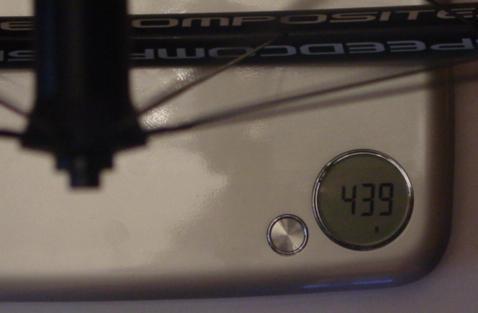
|
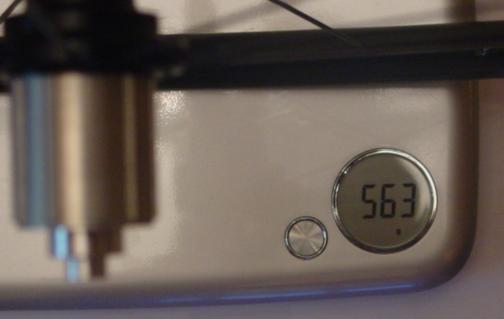
|
|
front wheel 439 gr |
rear wheel 563 gr |
We will firstly detail each component of the wheel before reviewing the set.
THE SPOKES
The dutch wheel maker trusts Sapim spokes and now proposes his wheels with the bladed Cx-ray spokes after requests made by some racers – It makes the wheels slightly stiffer. Beside this change, the specific shortened hidden nipples are filled with nylock that uses the principle of nylstop to prevent any tension loss of tension. The straight pull head of the spokes reduces the risk of failure and they are easier to hold and tighten because of their flat shape.

|
| Spécific nipples and black anodized spokes |
THE HUBS
The hubs are machinned out of an aluminium block. Upgraded for 2006, they are now even more reliable thanks to extra seals (seen in blue on the picture). The rear hub has 4 cartridge bearings, 2 of them are in the rotor and 2 in the hub body. Still looking for the best performance, the spokes are crossed on the non-drive side and touch each other; there is also the option to tie the spokes to add some extra stiffness.
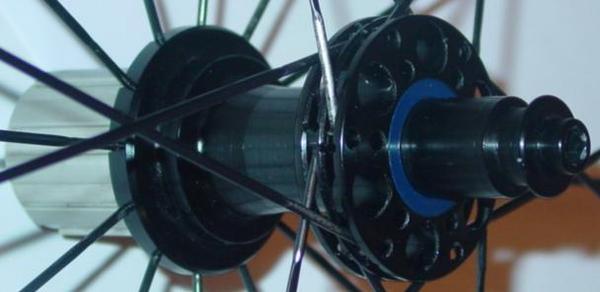
|
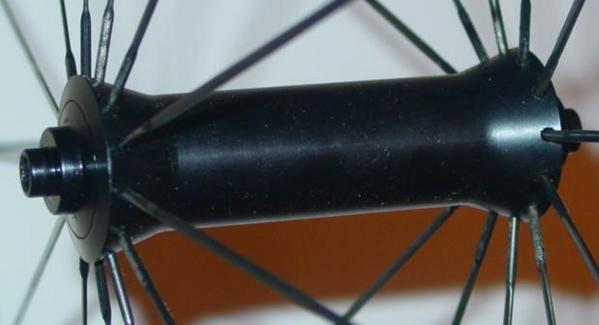
|
|
Rear hub 201 gr |
Front hub 81 gr |
The freehub body is light – it weights only 74gr including the bearings and the fitting is here awesome. There is no setting required, every parts fit each other perfectly, the play setting is the work of the craftsman who win recognition here. There are 3 wide free-hub pawls that guarantee a perfect torque transfer.
|
|
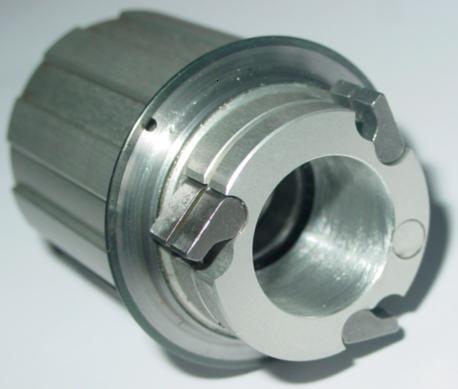
|
|
|
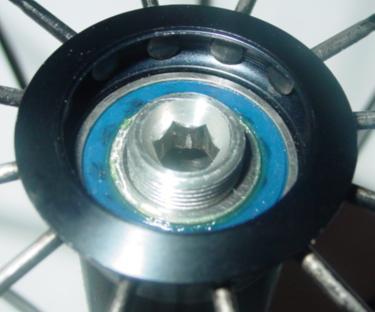
|
|
The dismantling requires a 10mm hex key. It saves again a few grams since it’s more machined than traditionnal axles. |
Front hub details |
THE RIMS
The rims are full carbon. Unidirectionnal fibre provides the rim with its finish, with discreet and well-finished stickers placed underneath glossy clearcoat so there is no need to worry about peeling them off after a few cleans. The bracking track has a matt finish and is machinned for better bracking performance. The rims are hollow, there is no additionnal foam inside that could certainly be useless since the size of the rim is quite small (width 21mm, height 25mm). The join is invisible, we guess this manufacturer secret will stay unknown for a while. The same rim is the same for both wheels and has a very nice, discreet, and slightly aerodynamical shape.
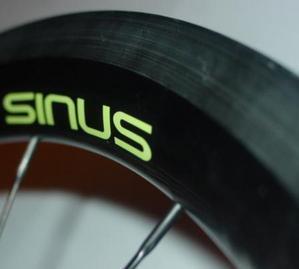
|
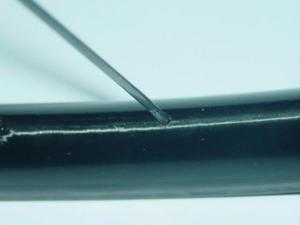
|
The spokes holes provided the most difficult part to achieve because of the strain concentration at the nipple. The solution used here to realize a strong and light rim (mean weight is 245-258gr) is to drill a very narrow hole (2.5mm) to let the spoke transfer most of the strain without weakening the rim.
THE WHEELS
We have detailed each part of the wheels, now we are going to analyse them. These wheels with their sharp finish and interesting look will best match dark carbon fibre bikes.
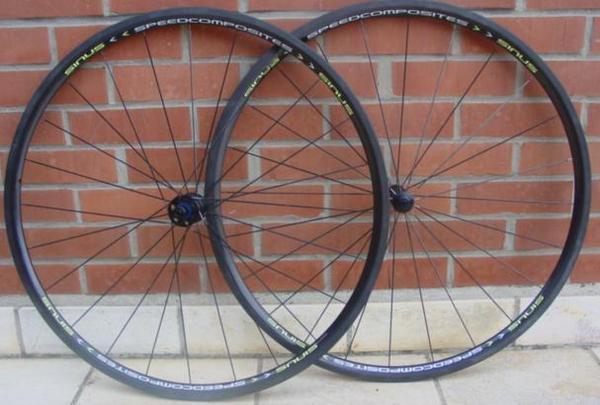
|
FRONT WHEEL
The front spoke pattern is radial and the hub has small flanges to reduce the material quantity used and therefore its weight. The distance between both flanges is 83mm which is a lot compared to 72-73mm for Shimano Dura-Ace, Campagnolo Record, DT Swiss 240 or Mavic Ksyrium ES. This width will increase the bracing angle of the wheel and so the lateral stiffness as well. On the other hand, this big bracing angle will make the wheel less aero. The spoke tension is 80-90kg.

|

|
REAR WHEEL
The rear spoke pattern is radial for the drive side and 2 times crossed for the opposite side, this solution is already used by Shimano and by Mavic who refer as IsoPulse. The solidity of the components and especially the rims allow an optimal spoke tension close to 70-110kg.

|
BEHAVIOUR
The built quality and the components used promise a strong wheel. These light wheels will allow you to accelerate quickly. The very light Cx-ray spokes bring some comfort to the wheel. With some good tubulars, the wheels will also absorb the imperfections of the road. In addition to this ride quality, the low inertia of the wheels is a great advantage at high speed when combined to a good stiffness. On the other side, it’s a disadvantage when cruising. Speedcomposites wheels give their best when the rider is accelerating or is climbing any kind of hill or mountain. The lightness will always outweight any disadvantadges, and will remain so.
About the braking power, it is better to use special brake pads. When the wheather is dry, a normal compound is suitable, it could even apply too much braking force and the wheel could block easily. The contrary would happen under wet conditions.
We have not been able to test the long-term reliability yet, but we will present you a long term test in a few months.
Lightweight on the scale but heavy performance

|
CONCLUSION
Whereas art and craft seems to be disappearing day by day in preference to marketing hype behalf, a brand new European artisanal firm producing in Europa and only thinking about the quality of its products is a good new for us.
Considering the product quality, we can expect a great reliability from the mechanical parts (hubs, free-wheel). The components machinning precision is so high that the wear will proportionnaly be lower. Afterwards low quantities productions give the builder a total control of his process and a perfect knowledge of his product. This wheelset will fit any kind of rider because it keeps comfort, strength but also efficiency regarding the weight to rigidity ratio. They perfectly compete with Campagnolo Hyperon Ultra, Zipp 202…etc with a superior finish, lighter and furthermore with an incredible price (about 1000 € the wheelset !!!).
Weight of similar wheels:
|
WHEELS |
WEIGHT |
| Lightweight Ventoux (DT Swiss) |
1020 gr (claimed weight) |
| Zipp 202 |
1032 gr (claimed weight) |
| Campagnolo Hyperon Ultra |
1220 gr (claimed weight) |
| Shimano Dura-ace 7801 carbone |
1310 gr (claimed weight) |
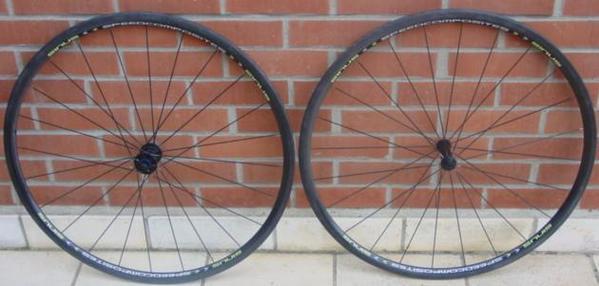
|